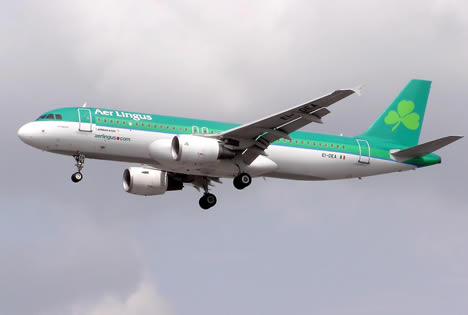
Aer Lingus. Airbus A320-200.
Photographed by Adrian Pingstone, May 2006.
Variations of Jet Engines
There are a wide variety of variations on turbojet engines, all of them designed to improve one or more performance factors over traditional turbojet engines. Some common variations are described below.
Turbofan Engines: Nearly all modern jet aircraft use a turbofan for propulsion.

Aer Lingus. Airbus A320-200.
Photographed by Adrian Pingstone, May 2006.
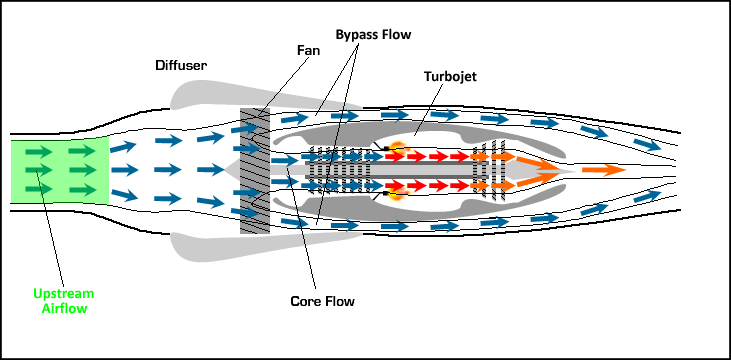 |
|
 |
|
 |
 |
|
A turbofan has several advantages over traditional propellers and turbojets. First, the diffuser on the shrouded fan slows the incoming airflow before it reaches the fan. This has the benefit of preventing shockwave formation on the blades at high speeds. As a result, turbofans are able to cruise at much higher speeds than traditional propellers without adverse effects caused by shockwaves forming on the fan blades. Second, the large diameter of the fan allows the engine to accelerate a much larger mass of air ( is increased). Because
is increased). Because  is larger, Ve - V0 can be less for the same thrust and cruise speed (here Ve is an average of the core and the bypass exit velocities). The larger the bypass ratio, the more Ve - V0 can be reduced for a given thrust. A smaller Ve - V0 leads to less kinetic energy left behind the engine (wasted) and the engine is more efficient. Equivalently, decreasing Ve / V0 increases propulsive efficiency as described in the Principles section. Typical high bypass ratio turbofans can easily achieve propulsive efficiencies that can compete with propellers (> 80%), but at higher cruise velocities than typical propellers can achieve. The lower jet exit velocities generated by turbofans also makes the engine quieter and reduces noise pollution near airports.
is larger, Ve - V0 can be less for the same thrust and cruise speed (here Ve is an average of the core and the bypass exit velocities). The larger the bypass ratio, the more Ve - V0 can be reduced for a given thrust. A smaller Ve - V0 leads to less kinetic energy left behind the engine (wasted) and the engine is more efficient. Equivalently, decreasing Ve / V0 increases propulsive efficiency as described in the Principles section. Typical high bypass ratio turbofans can easily achieve propulsive efficiencies that can compete with propellers (> 80%), but at higher cruise velocities than typical propellers can achieve. The lower jet exit velocities generated by turbofans also makes the engine quieter and reduces noise pollution near airports.
Turboprop Engines: A turboprop engine is basically a propeller driven by a turbojet. Alternatively, it can be viewed as a very large bypass ratio turbofan. It is not exactly a turbofan because there is no shroud or "duct" surrounding the propeller and the propeller does not spin as fast as a fan. The basic components of a turboprop are illustrated in the interactive animation below. Use the arrows to step through descriptions of the different components.
 |
|
 |
|
 |
 |
A turboprop engine enjoys the high efficiency of a propeller, owing to the large bypass ratio it provides. In fact, nearly all of the thrust generated by a turboprop is from the propeller. A turboprop also enjoys the high power-to-weight ratio of turbojet engines, resulting in a powerful compact propulsion system.
Turboprops also suffer from the limitations of propellers. Because propellers generate thrust by accelerating a lot of fluid (large  ) a small amount (small Ve - V0), they cannot achieve the same top speed as turbofans or turbojets. A further restriction is the potential to form shockwaves on the propeller blades, which reduces propeller efficiency at high speeds. Nevertheless, the efficiency of turboprops is appealing for lower speed missions and turboprops are commonly used on many smaller transport aircraft. This is especially true in today's market where rising fuel prices make turboprops the most viable option for short haul air carriers (see this article from Flightglobal.com).
) a small amount (small Ve - V0), they cannot achieve the same top speed as turbofans or turbojets. A further restriction is the potential to form shockwaves on the propeller blades, which reduces propeller efficiency at high speeds. Nevertheless, the efficiency of turboprops is appealing for lower speed missions and turboprops are commonly used on many smaller transport aircraft. This is especially true in today's market where rising fuel prices make turboprops the most viable option for short haul air carriers (see this article from Flightglobal.com).
Propfan Engine: The propfan engine is designed to have the speed and performance of a turbofan, but the fuel efficiency of a turboprop. The basic operation of a propfan is illustrated in the animation below. The propfan is also known as the unducted fan (UDF) engine because the fan is not enclosed like that of a turbofan.
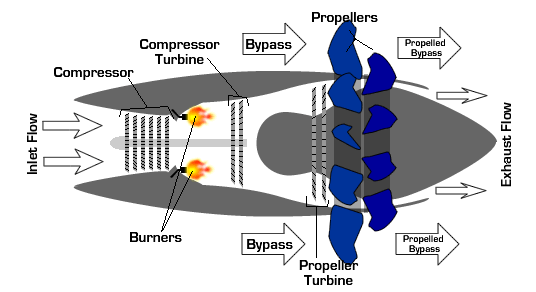
The propulsive efficiency of a propfan engine is increased by the high bypass ratio achieved using external fan blades. The efficiency boost is maintained even at high speeds because the fan blades are curved like scimitars to prevent shockwave formation on the outer tips of the blades. The increased propulsive efficiencies translate into overall propulsive efficiency gains of as much as 20-25% over turbofans.
Propfans were developed in the 1980s in response to rising fuel prices caused by fuel shortages. Development and testing of GE's UDF concept progressed through the 1980s, but it was never adopted on a production aircraft as fuel prices began to decline toward the end of the 1980s. (For more information on the history and evolution of propfans see this article on Flightglobal.com). Recent increases in fuel prices, however, have spawned renewed interest in propfan designs (see this article for a report on engine manufacturers' efforts to improve fuel efficiency).
Pumpjet Engines: A form of jet propulsion used in aqueous applications is a pumpjet. A common design (shown in the animation below) is essentially a ducted propeller. In this situation, the propeller serves two functions: (1) it accelerates the incoming flow (like a traditional propeller), and (2) it increases the pressure of the flow (like a traditional pump or compressor). The flow is then further accelerated through a nozzle, converting the pressure added by the propeller into kinetic energy. The resulting high-speed jet generates thrust. Use the arrows in the interactive animation below to step through descriptions of the different components of a pumpjet.
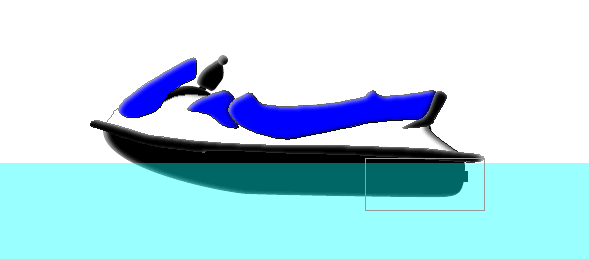
Inset shown below.
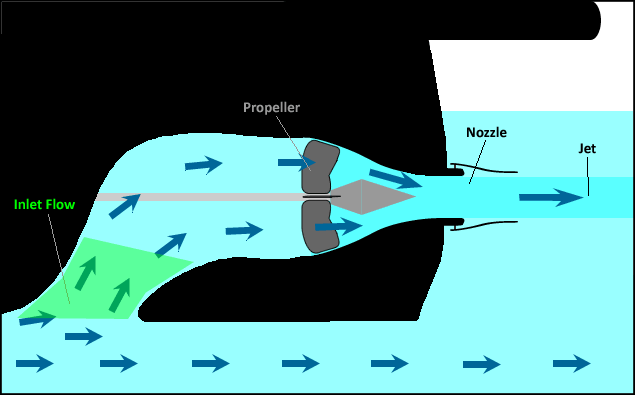 |
|
 |
|
 |
 |
The propeller in a pumpjet may be driven by any suitable system capable of generating mechanical power. Usually an (above-water) internal combustion engine is used. In contrast to non-shrouded propellers, the pressure across a pumpjet propeller increases, which helps delay cavitation. Consequently the propeller can be operated at higher speeds to create more thrust. The shroud also reduces the underwater noise associated with propulsion and prevents the propeller blades from being fouled by debris.
|
|
